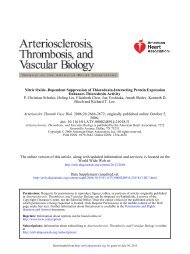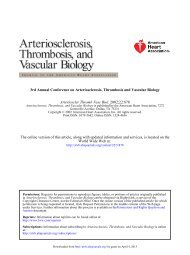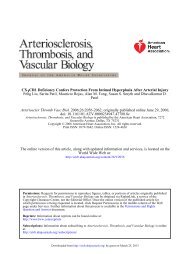1994;14;1751-1760 Arterioscler Thromb Vasc Biol AH Lichtenstein ...
1994;14;1751-1760 Arterioscler Thromb Vasc Biol AH Lichtenstein ...
1994;14;1751-1760 Arterioscler Thromb Vasc Biol AH Lichtenstein ...
- TAGS
- 1994
You also want an ePaper? Increase the reach of your titles
YUMPU automatically turns print PDFs into web optimized ePapers that Google loves.
o<br />
IT<br />
o<br />
o<br />
o<br />
O<br />
o<br />
160<br />
75<br />
BASE-<br />
UNE<br />
RfOUCED<br />
FAT<br />
LOW FAT<br />
- ENERGY<br />
LOW FAT<br />
I ENERGY<br />
o<br />
IT<br />
O 125<br />
X<br />
o<br />
O 100<br />
BASE-<br />
LINE<br />
REDUCED<br />
FAT<br />
<strong>Lichtenstein</strong> et al Low-Fat Diet, Weight Loss, and Plasma Lipids 1755<br />
LOW FAT<br />
- ENERGY<br />
LOW FAT<br />
1 ENERGY<br />
FIQ 1. Une plots of Individual plasma lipid concentrations at<br />
the end of each diet phase. See "Methods" for definitions of<br />
diets. LDL indicates low-density lipoprotein; HDL, high-density<br />
lipoprotein.<br />
and Fig 2). Postprandial plasma cholesterol and non-<br />
HDL-C concentrations were not significantly different<br />
from fasting values. In contrast, HDL-C concentrations<br />
consistently exhibited a postprandial fall of 5% to 7%,<br />
which was significantly different from fasting levels over<br />
all the diet phases.<br />
Mean postprandial plasma triglyceride concentrations<br />
(at 5-, 8-, and 10-hour time points) were approximately<br />
twofold higher than fasting values and were<br />
statistically different from fasting values for all diet<br />
phases. By 24 hours plasma triglyceride concentrations<br />
were statistically indistinguishable from the initial fasting<br />
values regardless of dietary treatment.<br />
The differences observed among diets with respect to<br />
postprandial total cholesterol, non-HDL-C, HDL-C,<br />
and triglyceride concentrations were similar to those<br />
observed in the fasting state. Postprandial total cholesterol<br />
concentrations were from lowest to highest when<br />
the subjects consumed the low-fat (j, energy), reducedfat,<br />
low-fat (-» energy), and baseline diets. In general,<br />
non-HDL-C concentrations were lowest when the subjects<br />
consumed the low-fat (| energy) and reduced-fat<br />
diets and highest when they consumed the low-fat<br />
(-> energy) and baseline diets. HDL-C concentrations<br />
were from lowest to highest when the subjects consumed<br />
the low-fat (—» energy), low-fat (j energy), reduced<br />
fat, and baseline diets. Postprandial triglyceride<br />
concentrations were significantly higher at the end of<br />
the low-fat (-» energy) diet than at the end of any of the<br />
other diet periods.<br />
The study subjects continued to consume the low-fat<br />
(| energy) diet for an additional 5 weeks (Table 5).<br />
Although there was a persistent loss of body weight,<br />
albeit at a somewhat slower rate (0.62±0.47 versus<br />
0.43±0.43 per week, first and second diet periods,<br />
respectively), the greatest effect of weight loss on<br />
plasma lipid and apolipoprotein concentrations occurred<br />
after the first 5 weeks of the fourth study period.<br />
Plasma lipid and apolipoprotein concentrations remained<br />
remarkably stable during the second 5-week<br />
period of the low-fat (J. energy) phase.<br />
Discussion<br />
Impressive observations have been made with respect<br />
to the benefits of extremely low-fat diets on plasma lipid<br />
concentrations and regression of atherosclerotic<br />
plaque. 6 ' 7 ' 58 Populations that normally consume low-fat<br />
diets are generally reported to have lower plasma lipid<br />
concentrations and rates of coronary heart disease than<br />
those consuming higher fat diets. 59 In such populations<br />
caloric intake tends to be lower and fiber intake higher<br />
than in societies consuming higher fat diets, and obesity<br />
is generally not cited as a major public health problem.<br />
5961 In general, the consumption of ad libitum<br />
quantities of low-fat diets relative to higher fat diets<br />
on an experimental basis is accompanied by weight<br />
loss. 45 ' 46 - 6268 Increasing the fat intake of people who<br />
habitually consume a low-fat diet has been reported to<br />
result in weight gain and adverse effects on plasma<br />
lipid concentrations. 69 The results of a recent metaanarysis<br />
of studies assessing the relation between<br />
weight change and plasma lipid levels concluded that<br />
weight loss is associated with an improvement of<br />
plasma lipid profiles. 70<br />
Taking these observations into consideration, we<br />
investigated the effects of reduced-fat and low-fat<br />
diets with and without weight loss on plasma lipid,<br />
lipoprotein, and apolipoprotein concentrations. Middle-aged<br />
and elderly female and male subjects with<br />
plasma LDL-C concentrations that indicated the need<br />
for dietary modification were targeted, since this is the<br />
group for which recommendations to reduce dietary<br />
fat content are frequently made. (Although body mass<br />
index was not a screening criterion, the group of<br />
subjects participating in the study, qualifying on the<br />
basis of having LDL-C levels above 130 mg/dL, had a<br />
somewhat elevated mean body mass index [27.0±4.5]).<br />
We do not have anthropometric measures of the study<br />
subjects, and differences in body fat distribution could<br />
have modified the effect of weight loss on their plasma<br />
lipid levels. Given that limitation, the results of the<br />
investigation suggest, relative to a baseline diet, that<br />
when body weight was maintained, reducing the total<br />
and saturated fat content of the diet in accordance<br />
with the current NCEP step 2 guidelines resulted in a<br />
significant decrease in total cholesterol, LDL-C, and<br />
HDL-C concentrations. Further reducing the total fat<br />
content of the diet under the same conditions also<br />
resulted in decreased concentrations of total cholesterol,<br />
LDL-C, and HDL-C, although the reductions in<br />
total cholesterol and LDL-C were less dramatic and<br />
the decrease in HDL-C greater than when the subjects<br />
consumed the reduced-fat diet. Accompanying these<br />
changes was a striking increase in plasma triglycerides<br />
and VLDL cholesterol concentrations. The end result<br />
was a less favorable plasma lipid profile with respect to<br />
cardiovascular risk. Allowing the subjects to decrease<br />
their caloric intake while maintaining the macronutri-<br />
Downloaded from<br />
http://atvb.ahajournals.org/ by guest on December 7, 2012














